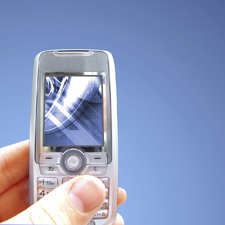 |

|
| |
|
| |
 |
 |
 |
Business |
| Banking is Going Mobile |
by John R. Quain |
| But carries continue to hamper advanced mobile services |
Citibank announced this month that it will start rolling out a mobile banking service intended for cell phone users. However, at a fog shrouded news conference at the top of Rockefeller Center, the future popularity of the Citi Mobile service seemed cloudy-- but not due to any lack of effort on part of the nation’s largest financial institution.
 To underscore just how important the bank views this introduction, Citigroup CEO Charles Prince was there to kick things off. Citi Mobile, he said, would launch this month in southern California and was expected to expand to other markets later this year. To underscore just how important the bank views this introduction, Citigroup CEO Charles Prince was there to kick things off. Citi Mobile, he said, would launch this month in southern California and was expected to expand to other markets later this year.
To use the free service, customers must download software to their handsets (it will work with over 100 different models). AT&T/Cingular, Sprint, and Verizon will also support Citi Mobile, which allow clients to conduct the sorts of banking activities currently available online. (Cingular has also announced plans to promote banking services from the likes of Wachovia and SunTrust.)
The snag is that in order to use Citi Mobile, you’ll incur additional data usage charges from the carriers. This harkens back to the day when we were charged by the byte to send e-mail. The problem is that in addition to standard monthly voice charges, there are charges for ring tones, downloadable games, Internet access, text messaging, and streaming video. The result: advanced services that require additional fees aren’t likely to take off any time soon. When there are lower flat fees for all-you-can-eat data service (see T-Mobile), then services like Citi Mobile might enter the mainstream. J-Q.com |

|
|
|
 |
 |

|
 |
 |
Panasonic's Plasma Push |
| The HDTV Battle: Picking a Winner |
by John R. Quain |
| Are LCD Sets the Future? |
Recently, Panasonic held its annual line show for members of the press to give us an early view of televisions and video equipment coming out this fall. While high-definition TV was the major theme of the show, Panasonic continued to underscore its view that flat panel plasma displays are the future. Indeed, the company is betting heavily on it, building state-of-the-art factories. Panasonic hopes to produce nearly 11.5 million plasma sets next year.
While Panasonic’s robots noiselessly press more and more panels each day, competing technologies, such as LCD and DLP continue to improve—and lower their prices. I believe LCD sets will ultimately replace conventional TVs in most American homes, but the question is, what should you buy now?

There’s no such thing as the perfect TV. There are advantages and disadvantages to each technology. To help you decide, here are the tradeoffs:
LCD: Liquid crystal displays are flat panel sets based on the same technology used in laptop displays. This technology offers some of the brightest pictures, making them great for brightly lit rooms. The drawbacks: poor contrast ratios mean that it’s difficult to see details in dark scenes in movies; some models have trouble reproducing green.
Plasma: Flat-panel plasma sets offer good color reproduction and wide viewing angles, making them a great choice for movie watching in normal or dimly lit rooms. The drawbacks: Images can look soft, most cannot do full 1080p resolution, and brightness is an issue.
DLP: Rear-projection DLP sets offer excellent contrast ratios, a pixel-free, cinema-like picture, and are relatively inexpensive, especially in screen sizes above 50-inches. The downside: some people see occasional “rainbow effect” artifacts and projection set bulbs need to be replaced every few years.
J-Q.com |

|
|
 |
 |
|
| |
 |
| |
 |
 |
Technology and in particular personal computers have had such an impact on our business lives that we often fail to notice their effects today. But finding and using the right technology for the task at hand is still a challenging process. In this section you'll find a variety of JQ's articles aimed at helping business owners, large and small. |
POWER TOOLS |
|
12 Ways to Boost Your Bottom Line |
by John R. Quain |
1: VoIP
Booster Shot: Cuts communication costs while improving flexibility and adding services.
Most businesses have heard of voice over IP or VoIP phone service and its benefits. But according to a survey by technology consultants at Savatar only about 17 percent of SMBs have made the switch. Why? Because most Internet phone services don’t offer communications packages designed for small businesses. Now that’s changing with a variety of tiered services that can fit nearly any business model.
There are two basic types of VoIP service. The first is designed to replace your existing landline phone with VoIP. Such services are offered by traditional phone companies (AT&T’s CallVantage and Verizon’s VoiceWing), cable companies (Time Warner Cable’s Digital Phone and Comcast’s Digital Voice), and VoIP pioneers like Vonage and Packet8..... |
 |
|
 |
 |
|
|
|
|
|
